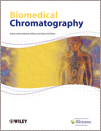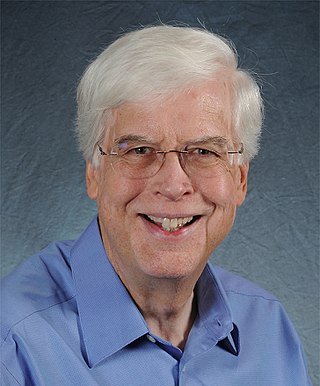
Analytical chemistry studies and uses instruments and methods to separate, identify, and quantify matter. In practice, separation, identification or quantification may constitute the entire analysis or be combined with another method. Separation isolates analytes. Qualitative analysis identifies analytes, while quantitative analysis determines the numerical amount or concentration.
In chemical analysis, chromatography is a laboratory technique for the separation of a mixture into its components. The mixture is dissolved in a fluid solvent called the mobile phase, which carries it through a system on which a material called the stationary phase is fixed. Because the different constituents of the mixture tend to have different affinities for the stationary phase and are retained for different lengths of time depending on their interactions with its surface sites, the constituents travel at different apparent velocities in the mobile fluid, causing them to separate. The separation is based on the differential partitioning between the mobile and the stationary phases. Subtle differences in a compound's partition coefficient result in differential retention on the stationary phase and thus affect the separation.

Thin-layer chromatography (TLC) is a chromatography technique that separates components in non-volatile mixtures.

Metaxalone, sold under the brand name Skelaxin, is a muscle relaxant medication used to relax muscles and relieve pain caused by strains, sprains, and other musculoskeletal conditions. Its exact mechanism of action is not known, but it may be due to general central nervous system depression. It is a moderately strong muscle relaxant, with relatively low incidence of side effects.

Richard Neil Zare is the Marguerite Blake Wilbur Professor in Natural Science and a Professor of Chemistry at Stanford University. Throughout his career, Zare has made a considerable impact in physical chemistry and analytical chemistry, particularly through the development of laser-induced fluorescence (LIF) and the study of chemical reactions at the molecular and nanoscale level. LIF is an extremely sensitive technique with applications ranging from analytical chemistry and molecular biology to astrophysics. One of its applications was the sequencing of the human genome.

Biomedical Chromatography is a monthly peer-reviewed scientific journal, published since 1986 by John Wiley & Sons. It covers research on the applications of chromatography and allied techniques in the biological and medical sciences. The editor-in-chief is Michael Bartlett.

The Journal of Chromatography A is a peer-reviewed scientific journal publishing research papers in analytical chemistry, with a focus on techniques and methods used for the separation and identification of mixtures.
Fred Warren McLafferty was an American chemist known for his work in mass spectrometry. He is best known for the McLafferty rearrangement reaction that was observed with mass spectrometry. With Roland Gohlke, he pioneered the technique of gas chromatography–mass spectrometry. He is also known for electron-capture dissociation, a method of fragmenting gas-phase ions.
Michael L. Gross is Professor of Chemistry, Medicine, and Immunology, at Washington University in St. Louis. He was formerly Professor of Chemistry at the University of Nebraska-Lincoln from 1968–1994. He is recognized for his contributions to the field of mass spectrometry and ion chemistry. He is credited with the discovery of distonic ions, chemical species containing a radical and an ionic site on different atoms of the same molecule.

Two-dimensional chromatography is a type of chromatographic technique in which the injected sample is separated by passing through two different separation stages. Two different chromatographic columns are connected in sequence, and the effluent from the first system is transferred onto the second column. Typically the second column has a different separation mechanism, so that bands that are poorly resolved from the first column may be completely separated in the second column. Alternately, the two columns might run at different temperatures. During the second stage of separation the rate at which the separation occurs must be faster than the first stage, since there is still only a single detector. The plane surface is amenable to sequential development in two directions using two different solvents.

4'-Methoxy-α-pyrrolidinopropiophenone (MOPPP) is a stimulant designer drug of the pyrrolidinophenone class. It has the potential to produce euphoria, an effect shared with other classical stimulants.

Bioanalysis is a biweekly peer-reviewed scientific journal established in 2009 and published by Future Science. The editor-in-chief is Neil Spooner. The journal covers the field of bioanalysis, including drug and metabolite assays, chromatography and separation sciences, ligand binding assays, metabolomics, and key detection methods.

Milos Vratislav Novotny is an American chemist, currently the Distinguished Professor Emeritus and Director of the Novotny Glycoscience Laboratory and the Institute for Pheromone Research at Indiana University, and also a published author. Milos Novotny received his Bachelor of Science from the University of Brno, Czechoslovakia in 1962. In 1965, Novotny received his Ph.D. at the University of Brno. Novotny also holds honorary doctorates from Uppsala University, Masaryk University and Charles University, and he has been a major figure in analytical separation methods. Novotny was recognized for the development of PAGE Polyacrylamide Gel-filled Capillaries for Capillary Electrophoresis in 1993. In his years of work dedicated to analytical chemistry he has earned a reputation for being especially innovative in the field and has contributed a great deal to several analytical separation methods. Most notably, Milos has worked a great deal with microcolumn separation techniques of liquid chromatography, supercritical fluid chromatography, and capillary electrophoresis. Additionally, he is highly acclaimed for his research in proteomics and glycoanalysis and for identifying the first mammalian pheromones.
Marjorie Janice Groothuis Horning was an American biochemist and pharmacologist. She was considered to be a pioneer of chromatography for her work in developing new techniques and applying them to the study of drug metabolism. She demonstrated that drugs and their metabolites can be transferred from a pregnant woman to her developing child, and later through breast milk, from a mother to a baby. Horning's work made possible the prevention of birth defects, as doctors began to warn of the dangers of drugs, alcohol, and smoking during pregnancy.

James Wallace Jorgenson is an American academic who previously held the position of William Rand Kenan Jr. Distinguished Professor of Chemistry at UNC-Chapel Hill. He is best known for his work developing capillary zone electrophoresis, and is a member of the American Academy of Arts and Sciences.
The Journal of Chromatographic Science (JCS) is a peer reviewed academic journal of chromatography. It is published by Oxford University Press. The Journal focuses on research papers describing practical and preparative applications and analytical methods relevant to a broad range of laboratory work. The editors-in-chief are Huba Kalász and Neil Danielson. According to the Journal Citation Reports, the journal has a 2020 impact factor of 1.618.

The Journal of Separation Science is a biweekly peer-reviewed scientific journal covering analytical chemistry. It was established in 1978 as the Journal of High Resolution Chromatography & Chromatography Communications: HRC & CC. In 1989, it was renamed the Journal of High Resolution Chromatography. It obtained its current name in 2001, when it also absorbed the preexisting Journal of Microcolumn Separations, which had been established in 1989. It is an organ of the European Society for Separation Science and the California Separation Science Society. The editor-in-chief is František Švec. According to the Journal Citation Reports, the journal has a 2020 impact factor of 3.645, ranking it 25th out of 83 journals in the category "Chemistry, Analytical".
Charles Wilkins is an American chemist who is a distinguished professor of chemistry and biochemistry at the University of Arkansas and the founding director of the University of Arkansas Statewide Mass Spectrometry Facility.
Acta Chromatographica is a quarterly peer-reviewed scientific journal published by Akadémiai Kiadó. It covers research on all aspects of chromatography. The current editors-in-chief was Teresa Kowalska and is Mieczyslaw Sajewicz. It was established in 1992 by the Institute of Chemistry at the University of Silesia in Katowice, and is gold open access.












